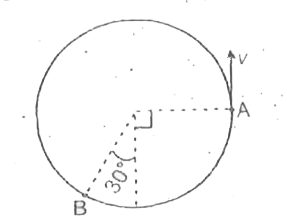An object of mass m moves with constant speed in a circular path of radius r under the action of a force of constant magnitude F. the kinetic energy of object is
12FR
FR
2FR
14FR
The correct Answer is:A
To find the kinetic energy of an object of mass m moving with constant speed in a circular path of radius r under the action of a constant force F, we can follow these steps:
Step 1: Understand the relationship between force and circular motion
In uniform circular motion, the net force acting on the object is the centripetal force, which is required to keep the object moving in a circle. The centripetal force Fc is given by the formula:
Fc=mv2r
where v is the constant speed of the object.
Step 2: Relate the constant force to centripetal force
Since it is given that the object is moving under the action of a constant force F, we can equate this force to the centripetal force:
F=mv2r
Step 3: Solve for v2
Rearranging the equation to solve for v2:
mv2=Fr⟹v2=Frm
Step 4: Write the expression for kinetic energy
The kinetic energy KE of the object is given by:
KE=12mv2
Step 5: Substitute v2 into the kinetic energy formula
Now, substitute the expression for v2 into the kinetic energy formula:
KE=12m(Frm)
Step 6: Simplify the expression
Simplifying the expression gives:
KE=12⋅Fr
Final Answer
Thus, the kinetic energy of the object is:
KE=Fr2
In uniform circular motion, the net force acting on the object is the centripetal force, which is required to keep the object moving in a circle. The centripetal force Fc is given by the formula:
Fc=mv2r
where v is the constant speed of the object.
Since it is given that the object is moving under the action of a constant force F, we can equate this force to the centripetal force:
F=mv2r
Rearranging the equation to solve for v2:
mv2=Fr⟹v2=Frm
The kinetic energy KE of the object is given by:
KE=12mv2
Now, substitute the expression for v2 into the kinetic energy formula:
KE=12m(Frm)
Simplifying the expression gives:
KE=12⋅Fr
Thus, the kinetic energy of the object is:
KE=Fr2
Similar Questions
Knowledge Check
A particle of mass M moves with constant speed along a circular path of radius r under the action of a force F. Its speed is
A√rFmB√FrC√FmrD√FmrA particle of mass 'm' moves with a constant speed along a circular path of radius r under the action of a force F .Its speed is given by
A√FrmB√FmrC√FrD√FmrA particle moves with constant speed v along a circular path of radius r and completes the circle in time T. The acceleration of the particle is
A2πv/TB2πr/TC2πr2/TD2πv2/T
Charged particle of charge q mass m moves in a circular path of radius r under the action of force F .The equivalent current is
View SolutionA particle of mass m moves with constant speed v on a circular path of radius r as shown in figure. The average force on it during its motion from A to B is

View SolutionAnelectron of mass m, moves around the nucleus in a circular orbit of radius r under the action of ccentripetal force F. The equivalent electric current is
View SolutionA particle of mass m moves in a circular path of radius r, under the action of force which delivers it constant power p and increases its speed. The angular acceleration of particle at time (t) is proportional
View SolutionIf a body of mass m is moving along a horizontalcircle of radius R, under the action of centripetal force equal to K/R2where K is constant then the kinetic energy of the particle will be
View Solution
